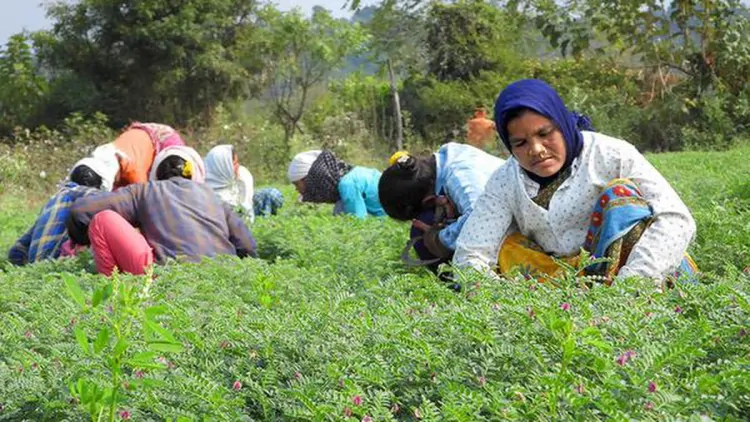Chickpea Farming in India: A Comprehensive Guide
Chickpeas, a vital protein source and natural nitrogen fixer, are widely grown in India, particularly during the Rabi season (October to March).

India has always been one of the major producers of chickpeas. Chickpeas, also known as gram or chana, are one of the most valuable pulses in Indian agriculture. They are a major source of protein for millions of people and are a key means for replenishing soil nitrogen.
Chickpeas are cultivated mainly in the Rabi season, from October and ends in March. Among all legumes, chickpeas are in great demand, and India accounts for 70% of the world’s bean production. The major producers of chickpeas are Madhya Pradesh, Maharashtra, Rajasthan, Uttar Pradesh, and Andhra Pradesh.
Cultivation Process of Chickpea Farming
For optimal growth, methods of cultivation are important to follow. Let’s learn more about it in detail:
Climatic Requirements
Chickpeas prefer semi-arid climatic conditions with moderate rainfall. Moreover, they prefer a temperature range between 24 and 30 degrees Celsius.
Soil Preparation
Ideal growth of chickpea crops requires efficient soil preparation. Chickpeas can be grown in loamy, sandy, or clay soil, but they mostly prefer well-drained loamy soil with a pH ranging between 6 and 7.5. Before preparing the seedbed, a Ploughing of 6-8 inches is required, which is done through an implement called Plough.
The next step is to break clods in the soil and provide proper aeration which is done through Rotavators. The 3-feet rotavators are mostly used by farmers in small-to-medium scale farming and are highly productive when paired with a reliable & robust tractor. For instance, Sonalika tractors are known for their compatibility with a wide range of agricultural implements, including 3-feet rotavators, making them a preferred choice among farmers. If you are planning to buy a rotavator, you must check the 3 feet rotavator price, specifications, and ensure it is compatible with your tractor for optimal performance.
Sowing
Planting is mostly done between October and November, depending on the area and climate. The optimal seed rate is 60 – 80 kg/ha. Chickpeas should be sown at a depth of 4-6 cm and spaced in rows with around half a meter between each row.
Seed germination is fundamental, and so is the use of certified seeds, which produce the best germination. Seeds can be treated with fungicides or biofertilizers to check for soil-borne diseases and increase nitrogen content. All this will help improve the crop yield.
Irrigation
Chickpeas are usually cultivated under low rainfall conditions. However, irrigation can enhance yields given insufficient rain conditions. The critical stages of irrigation are flowering, when the pod of the plant starts to develop, and seed development. However, overwatering the crop can lead to root rot and other diseases.
In cases of water scarcity, one might choose to employ drip irrigation or sprinkler systems on the farm. These methods guarantee adequate water supply to the roots and minimal water wastage.
Pest and Disease Management
Pod borer and aphid are some of the pests that affect chickpea crops. IPM can mitigate pest threats.
For example, a pheromone trap setting can be employed to monitor pod borer attacks on the crops. In the case of wilt and blight diseases, proper field inspection and timely spraying of bio-pesticides can help mitigate them. Moreover,
crop rotation and proper hygiene in the field are also other practices used in controlling diseases.
Nutrient Management
Chickpeas require the right nutrients to develop. Soil analysis should be carried out before planting to determine the nutrients available in the soil.
Generally, chickpeas need about 20-25N, 50-60P, and 20-25K per hectare or 213 kg N, 160 kg P, and 213 kg K per hectare. Phosphorus is essential because it stimulates root growth and fixes nitrogen. Farmers can also use bio-fertilizers such as rhizobium to increase nitrogen in the field.
Weed Control
Farmers must take measures to control weeds, as they will interfere with the growth of chickpeas. Weeds compete with them for nutrients, water, minerals, and light. Some methods for controlling weeds include hand weed removal or applying herbicides before emergence. The weeding must be done in at least two rounds for optimal growth of the crop. Tractors with inter-row cultivators remove weeds and maintain soil aeration between rows of crops. Tractors with inter-row cultivators remove weeds and maintain soil aeration between rows of crops. Using Sonalika tractors such as- Sonalika DI 60, Sonalika 745, Sonalika DI 750III etc, with inter-row cultivators is a smart choice for farmers looking to boost efficiency, reduce labor costs, and improve soil health.
Harvesting
The mature legume is harvested when the pods are dry and have a crunchy surface. This happens usually 90-120 days after sowing and may vary depending on the specific variety grown and environmental factors. Moreover, It is important to harvest the crop on time before it starts shattering or falling to pest attacks.
On the other hand, conventional harvesting methods involve slicing the plants at the base using a sickle, which takes a lot of time. However, modern harvesting equipment can do the job faster and with less labour costs.
Post-Harvest Management
Chickpeas are harvested by picking the pods, and after cleaning, the pods are threshed to remove the grains. It is recommended that grains should be dried to remove moisture content of between 10- 12 % before storage.
Farmers always store chickpeas in cool, dry places to avoid moisture and insect infection. For large-scale storage, farmers can use metal bins or hermetic storage bags to give them long shelf lives.
Conclusion
The potential for profit and sustainability in the farming of chickpeas in India is exemplary. The farmer may, therefore, be able to get high yields and quality produce from the crop by using the best practices of preparing the soil, planting, watering and protecting the crop from pests. Currently, chickpea farming can turn into a good emerging business for Indian farmers, as the market demand is high.
What's Your Reaction?
















